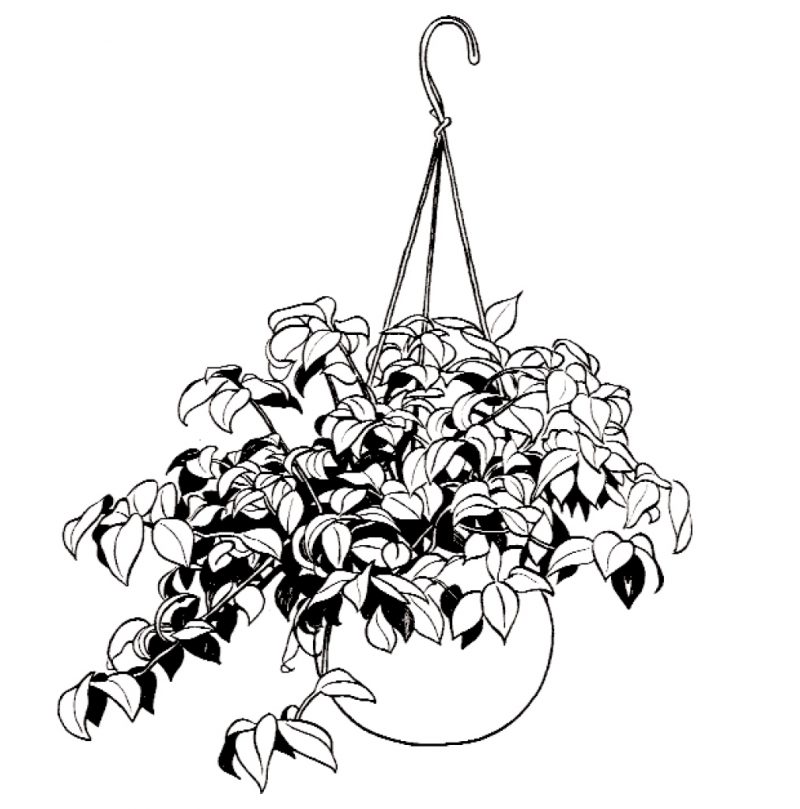Amid the burgeoning hulk of snarled branches lies the secret to this popular houseplant’s namesake—the pervasive medieval legend of Ahasuerus, the Wandering Jew. As an ornamental hanging plant, a decorative ground cover sown beneath park benches, a wild trailing decumbent found along forest floors on at least four continents, and as the protagonist in a recurring folktale of a man doomed to an eternal life of peregrination, the wandering Jew bewilders novice green thumbs and anthropomorphizes the Jewish Diaspora.
In its pendulous botanic form (Tradescantia Zebrina), the wandering Jew is a dense interlacing of hardy succulent foliage—if it were hair, it would be a single dreadlock, thick and matted yet mesmerizing. Among its tangles, the sessile leaves are a sheeny forest green with two silver strokes running lengthwise down the three-inch span of their pointy ovate bodies. Underneath, if they’re hale, the leaves acquire a lovely deep plum color. The tiniest of wispy hairs speck their tops like flaxen fuzz on a thirteen-year-old’s chin. Hairy, or piliferous, leaves deflect radiation and thereby conserve water; when moist, they acquire an airbrushed-seeming sheen. The leaves sprout on alternating nodes along either side of the plant’s purple- and green-mottled stems (fuzzy at the knuckles), which grow in abundance and in heedless directions. Given proper conditions—warm sunlight, some shade, and as much water as it can get—it will grow to no known end, either into a massive droopy bulk around a hanging basket or as a luxuriant forest carpet. Although it rarely flowers or reproduces through seeding, it’s a cinch to propagate by clipping a stem above a node and replanting it in airy soil. As a low-maintenance houseplant, the wandering Jew’s popularity peaked among American hipsters in the late 1970s, and, after a Reagan-era dormancy, it has undergone a marvelous revival in dorm rooms and offices and other generally neglected ecosystems.
The wandering Jew is indigenous to Mexico, but, thanks to its discoverer and original cross-ocean transmitter, John Tradescant the Younger, it’s now found across the globe. Tradescant delivered the plant to the European canon in the seventeenth century as booty gathered from one of his three voyages to explore, document, and pilfer the wealth of New World flora. In England it acquired both its scientific and colloquial names: Tradescantia after its horticulturally famed discoverer (He and his father have an entire genus of about thirty-five plants named after them), Zebrina (from the similarly striped animal), and Wandering Jew for its fantastic wanderlust.
Explanations and accounts of the legend of the Wandering Jew vary across the wealth of art, literature, and anthropology devoted to it. The most widely held version tells of the cobbler Ahasuerus, who, after shooing a crossbearing and particularly temperamental Jesus off his doorstep, was cursed to an eternal life of wayfaring. “Get off! Away with you, away,” demanded Ahasuerus; to which Jesus replied, “Truly I go away, and that quickly, but tarry thou till I come.” And that was that, the legend has it. From then until the Second Coming, Ahasuerus was stuck in a Sisyphean nightmare, (probably) wishing he hadn’t opened his mouth. Since that star-crossed day, witnesses have noted sightings of and encounters with the Wandering Jew throughout Eastern Europe, the Middle East, and, as recently as the nineteenth century, in America.
In his seminal text on the legend, George K. Anderson describes Ahasuerus as, among other things, an expression of the Diaspora, and therein lies the aforementioned secret behind the nomenclature of this delicate yet beastly plant: If given a nourishing apposite home, where it can exist without senseless aggravation by its allies and violent attacks from its competition, which undoubtedly will be reciprocal and cyclical, the Wandering Jew will prosper alongside its cohabitants. Otherwise it will wander and fight and be fought against and the world will forever be like a rose bush in Siberia.





